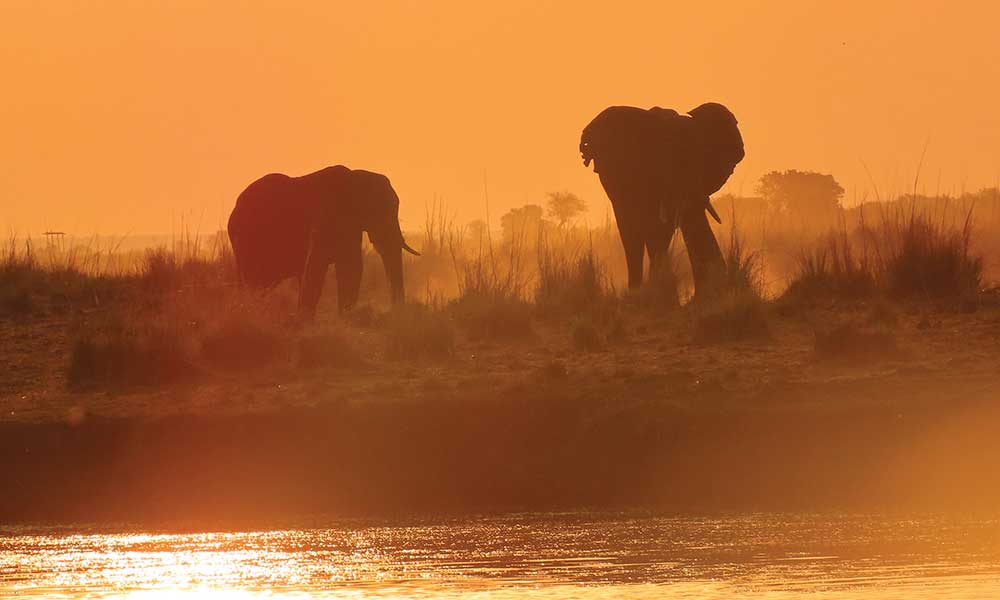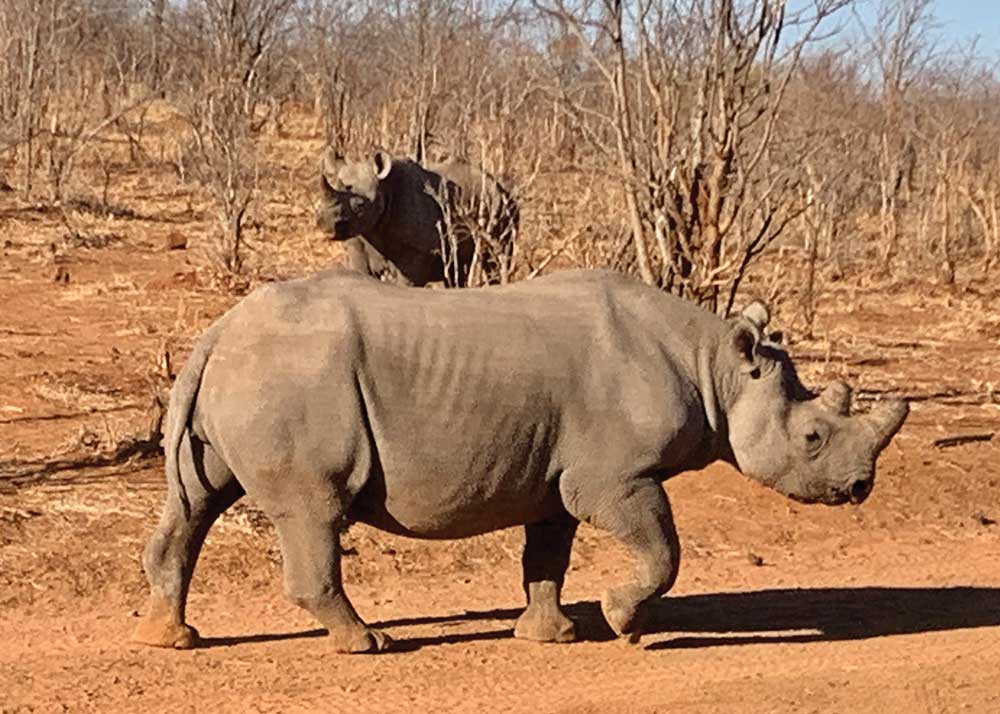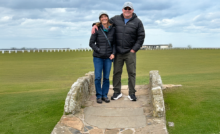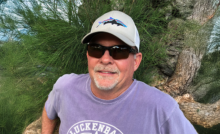Golfing in Africa – Making the Rounds: Part 7


Elephants at Sunset by the Water
This column features the author’s recollections of his 32 years as a golf writer. These installments stem from his many travels and experiences, which led to a gradual understanding that the game has many intriguing components, especially its people.
I didn’t go to Africa to play golf. I didn’t even bring a sleeve of golf balls, let alone clubs, shoes, tees, etc. This would be a different kind of trip, one consisting of seeing creatures my wife Anni and I had observed only in zoos. Beasts like elephants, lions, leopards, African (or Cape) buffalo, baboons, impalas, hippos, zebras, giraffes, rhinoceros, and birds of a million colored feathers.


We were part of a small tour group in southern Africa, an 18-day adventure with stops in South Africa, Zimbabwe, Zambia, Botswana, and Namibia. The round trip from our Seattle home was roughly 30,000 air miles. These included two 14-hour along with 8- and 10-hour flights, and much waiting in airports – especially Dubai’s, the world’s third-busiest hub. After returning home, we estimated we’d endured well over 20 passport and security checks.
Our days were filled with early-morning and late-afternoon safari drives or river cruises in national parks and wildlife refuges. We also went to famous places like Soweto Township in Johannesburg, the mile-plus-wide Victoria Falls, and Table Mountain in Cape Town. But with an open afternoon early in our stay, Anni and I, along with a couple from Houston, Mike, and Leslie, opted for a quick round in 95-degree afternoon heat. We taxied from our 116-year-old Victoria Falls Hotel to nearby Elephant Hills, a course designed by South Africa’s most famous golfer, Gary Player.
Upon arrival, we were met by several locals who led us up to the thatched-roof clubhouse. There, we secured our rental clubs ($6 a set), used balls (a dollar each) and caddies ($6 for nine holes), and paid the green fees ($8). Since it was late September, and just before the rains would hopefully come (much of Africa got only 30 percent of its annual precipitation the previous year), the layout was brown, except for the putting surfaces which, in some cases, were overwatered by old-style, pop-up sprinklers.
We were the only people on the course. But we were not alone. Romping across the roughs and nearby fairways were agile vervet monkeys, warthogs, impalas, crocodiles, and, as we were told by our caddies – Robert, Watson, Freedom, and Trust – highly venomous black mamba snakes. (Other interesting-named folks we met on the trip included Innocent, Africa, Truth, and “Big Mike,” a 5’9” guide and a great photographer.) In addition, gigantic termite mounds – one of the predominant geographical features of this trip – were everywhere.
My rented driver felt like a poleaxe, so I hit a 3-wood after the first hole for better control. After a well-placed tee shot on the par-4 18th (we started on the 10th tee), I asked my caddie, “Where’s the flag?” After staring at the distant green for a few seconds, he replied, “A monkey probably took it out.” Sure enough, when we walked up to the green, my ball was 12 feet from the cup, and lying nearby was the pin, yanked prematurely by the pesky vervet sitting nearby.
That’s the extent of my African golf experience, as the rest of our time was devoted to seeing an array of incredible animals. Visitors to this exotic place often seek to photograph the “Big Five” – lion, leopard, rhino, elephant and African buffalo, which we accomplished handily. Talking about big, we also saw many hippos, considered the continent’s most dangerous animal. These unpredictable and aggressive giants kill an estimated 500 people a year in Africa. Needless to say, we steered clear of these ton-plus behemoths on the river cruises.
Here are some personal observations of this wondrous part of our world:
- You can immediately see that Johannesburg is much different than other major cities as virtually every home, commercial entity, school, and building is surrounded by formidable steel fencing or stone walls topped with menacing barbed wire. White and black owners alike erect these protective measures, placing security-related services and businesses atop the list of Jo-burg’s most-profitable enterprises.
- Soweto, the epicenter of South Africa’s anti-Apartheid movement, is the country’s largest township, with 4 million people. Its story is long and complicated. Essentially, the uprising among blacks against a brutal white-controlled regime came to a head because the government decreed that Soweto’s all-black schools teach the students Afrikaans. This was the language of their oppressors and it was reviled. After already being forced to learn English, the students refused to obey this latest mandate, and the soldiers moved in, shooting 13-year-old Hector Pieterson. Sam Nzima captured the murdered boy in an iconic photograph, which helped mobilize the movement toward a democracy and voting rights for all. Hector’s older sister, Antoinette Sithole, gave us a moving first-hand account of what happened on that fateful June 16, 1976, day.
Soweto’s shanties and ramshackle homes are not surrounded by fences and barbed wire. But nearly every one of them has a television dish on its roof. Despite the rampant poverty, Soweto has a warm, friendly vibe. It was quite evident the township residents take care of one another. - Zimbabwe’s economy is in dire straits for various reasons, not the least of which is onerous tariffs on imported goods. (Government corruption is widespread in many of Africa’s 54 countries, which further represses national economies and job opportunities for citizens.) Zimbabweans are more than happy to accept U.S. dollars. Despite its financial woes, the nation is a wildlife wonderland. Our group was lucky enough to observe three extremely rare black rhinos. The well-patrolled location of these magnificent animals – now nearly extinct as their horns are each worth upwards of $400,000 in Asia – is kept secret because of poachers.
- At Victoria Falls Hotel, we heard an enchanting talk about David Livingstone by a local historian. Besides crossing the African continent many times and, amazingly, making these arduous passages relatively unscathed, the Scotsman was crucial in helping abolish the African slave trade run by the Portuguese and Arabs until the mid-1800s. He was eventually “found” by Welsh journalist Henry Morton Stanley, who greeted him with the famous, “Dr. Livingstone I presume?”
- In Victoria Falls we visited a local grade school. The impoverished kids eagerly greeted our pale faces and staged an enthusiastic dance. Tour groups before us had performed in-kind songs and skits. Our “act” was a game of “Simon Says,” which generated peals of laughter among the youngsters, teachers and American visitors. We all bonded immediately. Before leaving, many of us donated the books we’d brought and purchased T-shirts, a portion of whose profits go directly to the school. This part of the trip was a highlight, mainly because of the kids’ unbridled joy in our visit and zest for learning.
- Chobe National Park in Botswana should be on the bucket list of any African visitor. Though the unpaved “roads” through the site near the Okavango Delta and along the Chobe River are brutal on the body, the rewards are sublime. We saw lions feeding on a dead elephant, hippos and giraffes along with herds of elephants and massive African buffalo roaming the plains. A mother crocodile protected her eggs, while zebras, warthogs and other creatures romped alongside and in the river.
- The same can be said about the privately owned, 200-hectare (494-acre) wildlife sanctuary that’s part of the Royal Zambezi Lodge in Zambia, as well as the nearby Lower Zambezi National Park. The lodge’s owner made billions in the mining industry; it’s quite clear he doesn’t consider this particular property (a former Zambian king’s estate) as a money-maker. We were here before the onset of spring. Many folks hoped the rainy season came soon. To help the elephants – also routinely spotted from our individual guest rooms – management dug ponds filled with piped-in water. Another big outlay was spending over $40,000 a week for hay deliveries to the bush so the resident elephants could survive the sere conditions.
- Elephants are crucial to the life cycles of many African animals, who follow the giant beasts on their migrations. Elephants consume some 800 pounds of vegetation daily; they excrete 400 to 600 pounds of poop over the same time period. Everywhere the elephants go, so follow birds, warthogs, impalas and other critters seeking nourishment from the dung. Elephants also have an otherworldly knack for finding water. If they sense sub-surface sources, they use their massive girth to stomp out water holes for themselves and their followers. The elephants’ only predator is man.
- Our final stop was Cape Town, the continent’s southernmost city. Cape Town is one of two South African capitals (it’s the seat of Parliament and Pretoria is the legislative site). Sitting at the confluence of the Atlantic and Indian oceans, this is Africa’s oldest European settlement. It was first “discovered” by Bartolomeu Dias in 1488. A fellow Portuguese explorer, Vasco de Gama, recorded spotting the Cape of Good Hope nine years later. We visited the Cape of Good Hope, managing to beat the droves of tourists who flock to this unremarkable landmark for a quick snapshot. The city itself is more affluent and cosmopolitan than Jo-burg, with far less barbed wire. Cape Town’s waterfront on Table Bay is alive with boats, attractions, restaurants, museums and craft shops, which boast an astounding variety of locally-made products.
We ascended 3,500-foot Table Mountain via cable car, whose floor rotates 360 degrees so all passengers can glimpse the sprawling cityscape and sun-glistened waters below. The very precipitous ride is closed during foggy and windy weather. We lucked out and got there right after the fog had cleared and before many other tour buses arrived. Due to frigid ocean breezes, the vistas at the top were literally breathtaking.
For once, golf was a mere sidelight for this adventure. But I couldn’t have been happier after experiencing the raw landscapes, free-roaming, and exotic creatures, and especially, the friendly and welcoming African people.
Jeff Shelley has written and published nine books as well as numerous articles for print and online media over the past 32 years. The Seattle resident is the co-founder of the Northwest Golf Media Association. He co-authored (with Michael Riste) “Championships & Friendships: The First 100 Years of the Pacific Northwest Golf Association.” In addition, he wrote three editions of the book, “Golf Courses of the Pacific Northwest.”
Recent Posts
Memphis Country Club: A Golfer’s Study in Precision and Tradition
If you have ever teed it up at Memphis Country Club, you know this isn’t…
Foley Company attains GCSAA Silver Partner Status
Foley Company, a leader in turf equipment innovation and technology, affirms its support of the…
Harrell’s continues longstanding support of the GCSAA Foundation
Harrell’s LLC, a leading distributor of customized agronomic products for turfgrass since 1941, has donated…
City of Orlando Announces New State-of-the-Art Driving Range at Dubsdread Golf Course
The City of Orlando is excited to announce the construction of a brand-new, state-of-the-art driving…
Discover Puerto Rico for Great Golf Trips and After-Round Activities, Amenities
Golfers cannot live by the game alone which is why Puerto Rico provides the perfect…
Q&A with a Multi-talented Golf Course Architect – Part 2: Making the Rounds – Installment 39
This column features recollections of the author’s 37 years as a golf writer. These installments…


